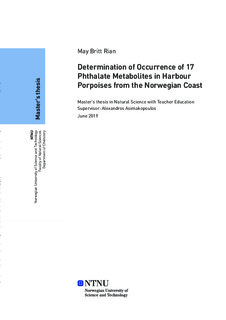| dc.contributor.advisor | Asimakopoulos, Alexandros | |
| dc.contributor.advisor | Ciesielski, Tomasz Maciej | |
| dc.contributor.advisor | Jenssen, Bjørn Munro | |
| dc.contributor.author | Rian, May Britt | |
| dc.date.accessioned | 2019-08-23T14:00:08Z | |
| dc.date.available | 2019-08-23T14:00:08Z | |
| dc.date.issued | 2019 | |
| dc.identifier.uri | http://hdl.handle.net/11250/2610007 | |
| dc.description.abstract | Ftalater har mottatt betydelig oppmerksomhet grunnet høyt potensial for miljøforurensning og skadelige helseeffekter hos levende organismer. Forekomst av ftalatmetabolitter er godt etablert hos mennesker, men er i liten grad studert hos marine pattedyr. Niser (Phocoena phocoena) utsatt for bifangst i norsk fiskeindustri har blitt undersøkt for 17 ftalatmetabolitter. Væskekromatografi med tandem massespektrometri (LC-MS/MS) ble brukt for separasjon og identifikasjon av metabolittene, etter omfattende prøveforberedelser inkludert ultrasonisk ekstraksjon, solid fase ekstraksjon og enzymatisk dekonjugering. Lever ble valgt ut som prøvematriks fordi høyeste konsentrasjoner av de fleste metabolittene ble målt her. Leverprøver ble dermed brukt for å bestemme forekomst av ftalatmetabolitter i 100 niser. Ftalatmetabolitter ble observert i alle individer av studert populasjon. Totalt 14 av 17 metabolitter ble målt over deteksjonsgrensen i lever hos niser. Høyeste deteksjonsrate ble funnet for monoetylftalat (mEP; 100 %), etterfulgt av monoisobutylftalat (mIBP; 99 %), mono-n-butylftalat (mBP; 97 %) og monometylftalat (mMP; 69 %). Metabolitten mono(2-etyl-1-heksyl)ftalat (mEHP) ble funnet i alle prøver i relativt høye konsentrasjoner, men høyt bakgrunnsnivå i kontrollprøver indikerte kontaminering. Høyeste gjennomsnittlige konsentrasjoner ble målt for mono-n-nonylftalat (mNP; 48,1 ng/g ww), mBP (37,2 ng/g ww) og mIBP (41,1 ng/g ww). Så vidt jeg vet, er dette første studie som rapporterer forekomst av ftalatmetabolitter i leverprøver av marine pattedyr. | |
| dc.description.abstract | Phthalates have received considerable attention due to their high potential of environmental pollution and potential adverse health effects in living organisms. Occurrence of phthalates metabolites are well established in human populations, but is less studied in in marine mammals. Harbour porpoises (Phocoena phocoena) bycaught along the Norwegian coast were examined for 17 phthalate metabolites. Liquid chromatography tandem mass spectrometry (LC-MS/MS) was used to separate and identify the metabolites, after extensive sample preparation involving ultrasonic extraction, solid phase extraction and enzymatic deconjugation. Highest concentrations of the analytes were observed in liver, and consequently, liver was chosen as the sample matrix for determining occurrence of phthalate metabolites in 100 harbour porpoises. Phthalates metabolites were detected in all individuals of the population. A total of 14 out of 17 phthalate metabolites were detected in livers of harbour porpoises. Highest detection rates were found for monoethyl phthalate (mEP; 100 %), followed by monoisobutyl phthalate (mIBP; 99 %), mono-n-butyl phthalate (mBP; 97 %) and monomethyl phthalate (mMP; 69 %). Mono(2-ethyl-1-hexyl) phthalate (mEHP) was found in all samples in relatively high concentrations, but a high background was observed in control samples, indicating contamination. Highest mean concentrations were observed for mono-n-nonyl phthalate (mNP; 48.1 ng/g ww), mBP (37.2 ng/g ww) and mIBP (41.1 ng/g ww). To the best of my knowledge, this is the first study to report occurrence of phthalates metabolites in liver samples of marine mammals. | |
| dc.language | eng | |
| dc.publisher | NTNU | |
| dc.title | Determination of Occurrence of Phthalate Metabolites in Harbour Porpoises from the Norwegian Coast | |
| dc.type | Master thesis | |
